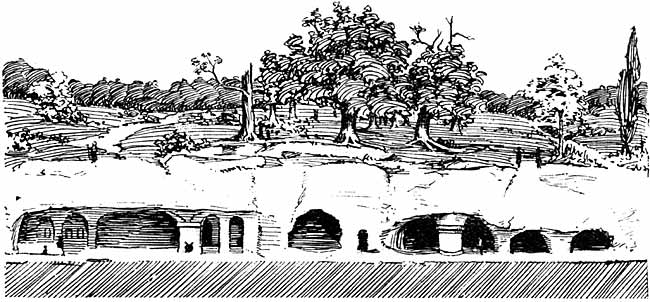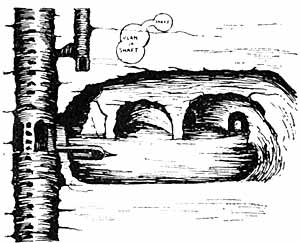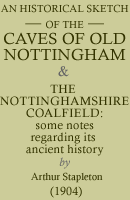II.
Subsequent to the Norman Conquest we find abundant evidence of the Nottingham caverns. It may be appropriate first to refer to the Castle. It was in 1068 that William, having first secured Warwick, marched north to Nottingham, which seems to have opened its gates to him. As he had done at Warwick, William secured his possession of Nottingham by building a castle here, which subsequently became one of the greatest fortresses of mediaeval England. It was described a little more than a century after the Conqueror's death, by William of Newburgh, the most thoughtful English historian of his time, as being so strong by nature and art as to be able to defy any force but that of hunger.
THE CASTLE PASSAGES.
The rock-cut passages at Nottingham Castle appear to have been extensive and numerous. Unfortunately, however, though in themselves practically indestructible, during later centuries they have mostly been stepped up, or filled, the entrances erased, &c. Moreover, no plan, nor even list of them, has been preserved. Consequently, when, as occasionally happens, thev are broken into during modem operations, the discoveries come to us as revelations. A series of such discoveries have transpired during the past hundred years.
It is remarkable that such stepped passages as occur on the southern cliff face have always an east-ward trend, in which circumstance possibly there may be something more than accident. Two of these occur in the Castle Rock, viz., Mortimer's Hole (tapping in its course the south end of the eastern ditch), and what may be distinguished as the Western Sallyport. Part of the roof of the latter has fallen in. Again, there is the ancient way called Long- stairs, belonging to the old fortified town, where the trend from east to west is the same. This last also was perhaps once a tunnel, which lost its roof ages ago.

Range of Excavations, Queen-street, destroyed on building General Post Office.
Regarding the Castle passages, we are met with the old puzzle as to their date, for they are void of character. Although some may be of later date, there can be no moral doubt that such works would be constructed in Norman times, as necessary appurtenances of the castle. But at least one high authority believes that Mortimer's Hole, a direct means of communication with the water at the foot of the rock, was in existence prior to the Conquest, and that it is possibly referable to Anglo-Saxon or Danish times.

Caves and shafts, King-street, now filled up. (4).
Another series of rock passages (one of them over 100 yards in length) were laid open in 1899, on the westward extension of the castle plateau, when excavating for a new wing to the General Hospital. The spot is outside the mediaeval castle, but within the town defences. The north end of the main hospital building stands on the site of an ancient mound, on disturbing which, over a century ago, a dagger and several interments were found. Under this place a winding passage less than four feet in height, and, consequently, only to be traversed in a stooping posture, led to a well over a hundred feet deep. It would appear as though the mound were anciently capable of defence, self-contained in regard to its water supply, and equipped with private sallyports.
Prisons.
In quitting for the present the subject of the castle—which in mediaeval times was largely used as a prison—we may briefly refer to the "King's Hall of the County," on High Pavement, and its near neighbour, the old Town Hall, Weekday-cross. Both these courts of justice, from times of impenetrable antiquity, were equipped with primitive, deep, rock-hewn dungeons, where numberless unfortunate human beings languished and died, and whence thousands, perhaps less unfortunate, were led forth to execution on Gallows Hill. The idea of a rock-hewn dungeon appears to have been adopted when the St. John's poorhouse and house of correction was- set up, in or about the year 1600. These places were not disused until comparatively modern times. All three were visited and described by Howard the philanthropist, towards the close of the eighteenth century.
Wide prevalence of excavations.
Although, as we have elsewhere hinted, only a very small proportion of local cave discoveries ever become recorded, it would yet be a heavier task than we should care to undertake to catalogue these scattered records. Deering, our first Nottingham historian, writing about 1745, says: "Structures of a very considerable extent, arched in a regular manner, and supported by columns with carved capitals, &c., framed for places of worship, hewn out of the rook, have been discovered bv workmen when digging for foundations, with very obscure entrances, hardly to be suspected, and also other apartments for lodging-places. Such were observed under divers houses on the Row, on the south side of the Great Maiket-place, called Timber Hill, and one Edward Gcddard, a bricklayer yet living, assures me that when he was an apprentice, being at work on the east side of the Weekday-cross, he there got into one of these subterranean fabrics, which he found supported and adorned with pillars, as has been mentioned, and that he made his way from one spacious place to another, till he came as far as the upper end of Pilcher-gate and under a small close at present the property of John Sherwin, Esq., and opposite to his dwelling-house. He, the said Goddard, says that in one of these places he found a wooden cup and a wooden can, which seemed to be sound and whole, but that when he took hold of them they mouldered into dust."
Mr. Hine records that several rock habitations were discovered in pulling down Plumptre House, and that one has been preserved underneath the warehouse of Mr. T. Birkin, in Broadway, where are three or four rooms encircling a small sunk courtyard, approached by steps leading from the surface of the ground. Mr. Stretton gives engravings of several of these ancient excavations. A rock dwelling was found when Old Queen-street was rebuilt, with a central column and a door and window. Probably this was in the ancient town ditch—which from its nature and position was always dry. In 1890 another was discovered in the neighbourhood of Pilcher-gate, but in none of these cases does there seem to have been any attempt at arriving at a date. The case was more satisfactory when, in the latter year, the ditch-dwelling was found in Warser-gate, as photographs were taken. It faced the north, and had two windows, with a door in the middle. A little wall of rock, some four feet high, separated it from the primitive ditch, then displayed for the first time in history.
Rock dwellings.
Though these ancient rock-dwellings may have been rude and unhealthy, they must have acted admirably in winter as a protection from the cold, and similarly in all extremes of weather. They usually had holes in the roof for the escape of smoke. But they were not all used as dwellings. Such as dwelt in wooden houses above ground, would largely resort to underground works for chapels, storeplaces, or refuges in times of war. The generality of drawings made by Mr. S. Clements, of Nottingham, suggest dates between 1100 and 1300, when Nottingham, as the seat of a castle, was constantly liable to trouble. Deering, apparently quoting Stowe, relates the account of the taking of Nottingham in 1140, by Robert, Earl of Gloucester, who, "with great power, invaded the town and spoiled it. The townsmen were taken, slain, or burnt in the churches, whereunto they fled. One of them, more rich than the rest, was taken, and led to his house by his takers, to show them where his treasure lay. He, bringing them into a low cellar, whilst they were busy to break open locks and coffers conveyed himself away, shutting the doors after him, and set fire to the house. And so the thieves, to the number of 30, were burnt: and by reason of this fire all the town was set in flames."
Wells.
One feature of these excavations we have not yet alluded to. Their floors being on a low level, it was a common practice to bore for water from them instead of from the ground level above. Vast numbers of such wells were sunk, judging from such as have been cut into during modern operations, and from the plentitude yet remaining, though long since disused. In view of this circumstance, together with what we know of actual occurrences in later times, the wells must have been a prominent factor in making up the death-rate of old Nottingham. One ancient roll tells of a man being drowned in a well at the castle. Another type of well appears to have obtained in the case of rock dwellings in the town cliff, entered from the meadow level, as we assume from what survived until just recently at Sneinton Hermitage. The water-level of the Trent valley being but a comparatively few feet below, stepped approaches were made thereto, and "scoop-wells" formed, comparatively free from danger. One of the few modern uses to which the rock excavations under Nottingham houses are occasionally put is that of a refuge during thunder-storms, for such as are nervous! Certainly there could not be safer places.
